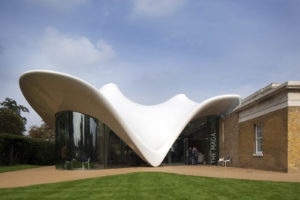
The late British master architect and Pritzker Prize winner worked in all the standard architectural materials, but many of her most striking designs aptly incorporated tensile fabric elements.
“Our work with Zaha Hadid’s office on the Serpentine Sackler Gallery addition,” says Lance Rowell, former CEO of Architen Landrell, “was, at the time (like with all great designers) ‘never an easy ride.’”
Rowell, in a phone conversation, recalled his firm’s working relationship with Hadid and her firm, Zaha Hadid & Associates (ZHA), over a number of major projects that used fabric including the Chanel Mobil Contemporary Art Container, the 2012 London Olympics Swimming Pavilion, and the Sackler Gallery. Rowell, who recently stepped aside from the top leadership position of the British fabric structures firm he founded, reminisced on a number of ZHA projects he was involved with.
BNW: What do you recall about working with Zaha Hadid on the various projects your firm completed with her?
Lance Rowell: “When I was first called to a meeting for the “Sackler Magazine” I thought they were talking about a publication, like Forbes or something. It was, in fact, a munitions storage building from the 19th century. [The 2013-14 project remodeled an underused storage structure, called the “Magazine,” located on the Kensington Gardens grounds that dates from 1805 and was used to store gunpowder during the Napoleonic Wars.]
“I remember taking notes during these meetings, thinking I’ll make note of all the ‘problems to be resolved;’ (meaning, problems of making fabric do what they said they wanted and that I felt sure were impossible), such as interior ceilings that are held up in tension (and there were five internal columns set at extreme angles that were problematic).
“At one point [on the project] I recall talking to the engineers [Arup] saying ‘We need to get some realism into this’ in terms of buildable shapes. This was an incredibly difficult project to build.”
BNW: And yet, the project is spectacular and a marvelous example of seamlessly integrating numerous disparate materials together.
LR: “With the Sackler, when all was said and done, when you go into the space your heart is uplifted. It is a fantastic building; it is great architecture. All the cost overruns are forgotten about when you see the results.”
OTHER FABRICATORS have built a strong working relationship with ZHA, such as Stage One, a UK firm specializing in events and custom fabrications. Edwin Stokes, materials engineering and R&D director, Stage One, also recalled his firm’s involvement with the architect:
Edwin Stokes: “The first and most notable project that we worked on with Zaha Hadid Architects was the Chanel Mobile Contemporary Art Container (or ‘Chanel Pavilion’, as we called it). Since then we have built a number of furniture pieces, such as the ‘Seoul Table’ and the ‘Z-Stream,’ at Suddeley Castle.”
“Our experience of working with ZHA was that each project had a strong design intent derived from a simple geometric principle, which developed in complexity with the various parameters particular to the design. Each project was highly complex to achieve, requiring a lot of work, skill and appropriate facilities to build.
“Whilst we did not work directly with Zaha Hadid herself, she had an input to each of the projects we worked on throughout their development. Continuity of form and quality of finish were of paramount importance. Geometric complexity and exacting quality requirements typically made the projects challenging to engineer and costly. The finished results were always impressive.

A history of using fabric
It is entirely appropriate that the Serpentine Gallery’s famous and iconic summer pavilions program was launched in the year 2000 by Zaha Hadid. Here was a major world talent, in the “backyard” so to speak [Hadid established her eponymous architectural practice in London], given free reign (but with a very restricted budget) to create whatever she liked for the engagement of the public on the beautiful grounds of the Kensington Gardens’ Serpentine Gallery.
Hadid’s 2000 pavilion was made of fabric and lightweight poles set in a zigzag configuration, a very strong structural system with minimal supports but strengthened by triangulation and taking full advantage of the tensile strength of very thin architectural fabric. The folded triangular plates of fabric, although not an ideal tensile form, hinted at her more recent masterpiece, the Sackler Gallery addition of 2013-14. Here, with the Sackler, is the same dramatic, forceful swoop of curves in a wave-like pattern, each “wave crest” of different amplitude, which produces incredible interest. Moreover, it appears to be floating, barely touching the ground at the low points, rising above the roofline of the older brick magazine building, an apt metaphor for the use of fabric as a building material.
With Hadid’s passing on March 31 at the relatively young age of 65, the world has lost an amazing creative force, and architecture is the better for her talent and production, however brief. Members of the ZHA staff have hinted at more projects to come that include fabric. We can only be grateful for her rich contributions to the techne of our profession.
 TEXTILES.ORG
TEXTILES.ORG


